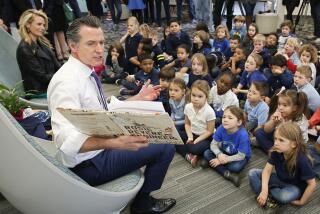EDUCATION : Reading Aloud Is Especially Important for Toddlers, Preschoolers
Most parents agree that a childâs skill and affection for reading can help determine his or her success in school. But too many parents overlook the first and most important step in raising a good reader: reading aloud to the young child.
Although it helps children of all ages, reading aloud is especially vital for toddlers and preschoolers to help them develop an early fondness for stories.
Your child will benefit in several ways.
First, your child will learn the most important key to all future learning: that reading is not to be feared and is enjoyable.
Reading aloud to your children makes the experience fun for them because they donât have to work as hard. They donât, for example, have to struggle with recognizing letters, sounding out words or turning pages in mid-sentence. The children can simply relax and focus on the suspense and pleasure of the story.
Listening to you read also helps children to learn the proper rhythm and flow of language, and the correct pronunciation of words. When children have not learned these basic skills, they will read in a choppy, monotone voice that will make any story seem boring and will discourage future reading.
But when you read aloud, you can demonstrate the proper inflection and fluidity that make printed words more dramatic and interesting.
Your bond with the child will also benefit, since reading aloud provides a period of physical and emotional closeness. Your attention and voice are reassuring to your son or daughter, and your own visible enjoyment of the book sets a powerful example.
Reading aloud to your toddler or infant can also help you monitor his or her vocabulary and basic comprehension skills, since you can stop and ask the child questions about the story.
This is true even with my teen-age literature students. Reading aloud the key passages of a novel, for example, helps me to ensure the studentsâ understanding of characters and events, and to launch discussions, just by asking quick questions along the way. Nearly all students, even the usually âlow-achievers,â earn Aâs on quizzes over material that I read aloud in class.
In fact, discussing what you read to your child is the most helpful part of reading aloud. Here are a few simple strategies for checking his or her comprehension and exercising critical thinking skills, such as analysis, speculation and evaluation.
Start with the title of the story. Ask the child what the title means and what the story might be about.
While reading the story, point out the illustrations. Ask the child, âWhat is this a picture of?â or âWhat is happening in this picture?â
Ask which characters the child likes, which he or she dislikes, and why.
At a suspenseful point in the story, ask your son or daughter, âWhat do you think will happen next?â
When the story is finished, help the child summarize the story by mentioning a particular event in the story, then asking, âthen what happened next?â
If the storyâs character is similar to one in another story, mention that to the child and ask how the characters are alike.
Finally, donât be alarmed if your toddler or preschooler doesnât remember or understand a story after hearing it just once. Young children generally absorb stories bit by bit and usually must hear them several times for a clear understanding.
Reading aloud to your child may mean rearranging your schedule or having a little less time to yourself. But it can also mean producing a ready and willing learner.
Mary Yarber teaches journalism and English at Santa Monica High School. She writes a weekly column on education for The Times.






